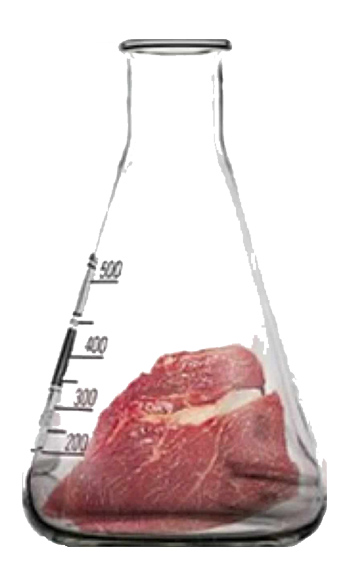Lab-Grown Meat
Column #161 
The earth is home to over seven billion people. A good number of them, more than ever before, are thinking about building better mousetraps. Consequently you’ve got to figure some better ones will come along. As they do each advancement is called new technology and new industries are created. That’s why it’s so amazing what’s being done these days and more amazing about what’s coming.
Recently we’ve been hearing a lot about veggie burgers. But are they being shoved aside by lab-grown or cultured meat? The science for cultured meat is an outgrowth of biotechnology’s tissue engineering field. It does not involve genetic engineering. It’s simply adding a collagen matrix (taken from either living or deceased animals) to adult muscle stem cells from a live animal and bathing them in a culture media of primarily photosynthetic algae and cyanobacteria.
Now if you think that growing meat in a petri dish is pretty far fetched, think again. Even Tyson, the huge Arkansas-based meat company that processes chicken, beef, and pork, recently bought out two fledgling cultured meat companies. Not to be left behind, Cargill recently announced an investment in Memphis Meats which has the proven technology and potential to commercialize cultured meat protein.
As early as 2008 PETA had offered a $1 million prize to the first company to bring lab-grown chicken meat to consumers by 2012. That was too early in the technology curve to be realistic, but four years from now lab-grown “beef” may be economically viable. For sure though, PETA knew there’s consumer interest in meat alternatives amid concerns about animal welfare and the environmental impact of livestock production. So that’s part of the sales pitch.
Trevor Amen, an economist for farm lender CoBank, thinks alternative protein products are one of the hottest food trends to watch this year although he still thinks it will be three to five years before it may be in restaurants and several more years later for it to be in grocery stores.
The FDA held a preliminary meeting on July 12, 2018 to get input from the industry on the safety of the technology, how to label the products, and over whether the FDA or the U.S. Department of Agriculture should regulate lab-grown meat. Another meeting will be held October 23–24, 2018 to discuss potential hazards, production, regulation, and labeling.
There is a big battle over the labeling. If it’s decided that lab-grown meat will be called meat, it’ll be regulated by the USDA. If it’s not allowed to be called meat, it’ll be looked after by the FDA. Already lawmakers in Missouri ruled that lab-grown “meats” cannot be called meat within the state (with violators facing large fines and imprisonment). Naturally cattlemen played a role in that new law. And at this moment we don’t know if cultured meat is just like real meat.
My concern revolves around the question of nutrient diversity in cultured meat. Of all food choices, grass-fed meats are one of the most nutrient diverse and dense. Can meat grown in a petri dish bath of photosynthetic algae and cyanobacteria have and develop all of the vitamins, amino acids, essential fats, protein, other fats, minerals, bioactive compounds, and sterols that a living animal would produce? Scientists have shown that getting more Omega-3 in cultured meats is easy although the fat we are used to seeing along with bones and organs must be grown separately. Vitamin B12 is one essential component that is NOT being produced by skeletal muscle cells. Therefore it would have to be added. In terms of everything else, apparently we’ll have to wait and see. The data isn’t public yet.
In the meantime we don’t have to fret because we have the real thing in grass-fed and Omega-3 meats. They are known to have all of the vitamins, amino acids, essential fats, protein, other fats, minerals, bioactive compounds, and sterols that we need as humans for optimizing health and well being. Aren’t we lucky to be so far ahead of the curve.
To your health.
Ted Slanker
Ted Slanker has been reporting on the fundamentals of nutritional research in publications, television and radio appearances, and at conferences since 1999. He condenses complex studies into the basics required for health and well-being. His eBook, The Real Diet of Man, is available online.
Don’t miss these links for additional reading:
Key Nutrients Delivered by Red Meat in the Diet by Professor Peter Williams Bsc (Hons) DipNutrDiet MHP PhD FDAA
Lab-Grown Meat: Exploring Potential Benefits and Challenges of Cellular Agriculture
Cultured Meat from Maastricht University
Tyson Foods Makes Another Investment in Lab-Grown Meat by Alisa Odenheimer from Bloomberg
Lab-Grown Meat Startups Backed by Bill Gates, Tyson Foods Face FDA Oversight by Anna Edney from Bloomberg
Protein Innovation: Cargill Invests in Cultured Meats from Cargil Inc.
Cultured Meat from Wikipedia
Tissue Engineering from Wikipedia
FDA and USDA Will Meet to Debate the Future of Lab-Grown Meat by Rachel England
July 12, 2018 Public Meeting on Foods Produced Using Animal Cell Culture Technology from The U.S. Food and Drug Administration
How to Fight Desertification and Reverse Climate Change by Allan Savory
Plant-Based Proteins by Ted Slanker




